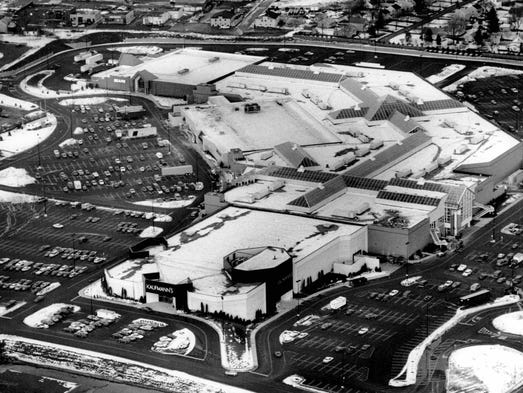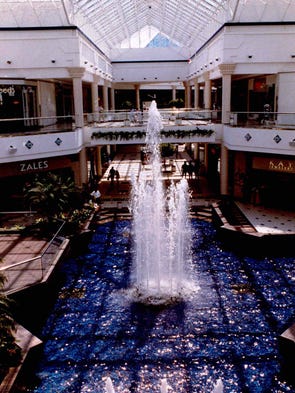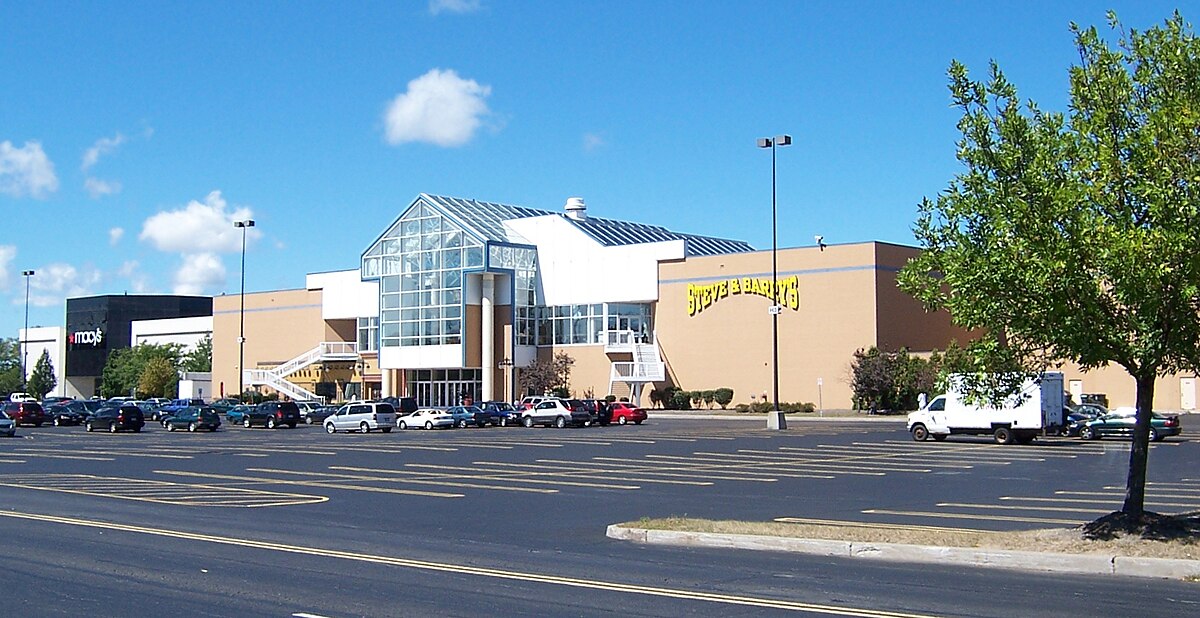While I can't visit a mall everyday, there are some I have no chance to get to anyway. That's the case with today's post.
The start of a mall's life doesn't always mean it will last. Those words were the case of the Irondequoit Mall. After a promising start, the mall crashed, burned, and fell into irrelevancy. Yet this didn't go without documentation. There seems to be a glut of information on this shopping center on the interwebs. News articles,
labelscar.com, other blogs, you name it. Controversy clouded the mall and its owners more than a typical Seattle day. It's an example of nearly every dead mall type : anchors outlived the mall, other malls got better, controversy, market oversaturation in a dying town (I apologize to any Seattle or Rochester residents), etc. Needless to say, the centre has one wild history.
Plans for the mall were first announced in 1985. Wilmorite Properties, the creator of two other Rochester shopping centers, had proposed to build a center there throughout the 1980's. The reason that it took five years to work wasn't about construction for the most part. Legal action took small delays on Wilmorite. Residents attempted to block the project, and another mall developer threatened to take things to court. A public meeting about the project took over six hours and was overfilled. The state Supreme Court finally gave Wilmorite the ability to construct the mall. The town supervisor in 1987 turned out to have a partnership in a shopping center planned across the street of the mall site, but the problem was solved when he sold the interest.
In May 1988, the anchors were announced: Sears, JCPenney, and Sibley's. During the time, May Company was consolidating their store names, so Sibley's became Kaufmann's. This was a bit of a disappointment, as Sibley's was a loved company in the area. Finally, in 1990, the mall's construction would be finished. The construction costs added up to $80 million dollars, but it seemed very much worth it from the start. After the first weekend, it was estimated 80,000 customers visited the mall, raking in $4 million dollars in revenue. Located on major roads - East Ridge Road and NY 104 - the mall had a premier location. Many were within easy reach of the mall.
 |
| Aerial photo of mall when it first opened. Sears and Kaufmann's names are visible. Photo from Democrat and Chronicle. |
Irondequoit Mall opened as Rochester's first two-story mall. The design was "open and airy", as customers called it. Impressive skylights lined the roof. The wide U shaped mall had Kaufmann's to the west, JCP in the middle, and Sears to the north. The mall contained two separate courts, with a large fountain in the middle. A food court was located at the top of a court. An Iroquois-inspired carousel was located on the second floor, and could be seen from the highway.
 |
| A 1992 view of the fountain in center court. Democrat and Chronicle. |
The 1990's brought the first wave of changes for the Irondequoit Mall, some good, some bad. A small expansion in 1992 brought Rochester-based McCurdy's to the anchor roster. Unfortunately, McCurdy's was on a course that led to it's purchase by Wisconsin and Pennsylvania-based Bon-Ton Stores. In 1995, Bon-Ton replaced the existing McCurdy's with a Bon-Ton (if it sounds weird, the company owns a few other stores).
While the mall enjoyed great success early on, in 1995, the tide turned for the center. Tremendous growth was occurring in neighboring Ontario County, and located there was Wilmorite's Eastview Mall. Eastview was looking dated, and Wilmorite knew the money a renovation there would bring. And that's just what they did. Yet another life-changing event happened for the mall the same year. Greece Ridge Mall formed after the grouping of two malls across the street of each other expanded, essentially sewing them together. The compounded improvement of the malls led to Irondequoit Mall falling to third in Rochester malls. It would turn out that Wilmorite did too well, as Eastview took out the customer base for Irondequoit Mall.
 |
| Stores line a mall corridor. Photo by Prange Way in 2010. |
What mainly killed the mall were lies, and I mean that literally (what most websites say about the mall's death is true, that wasn't what I meant). Non-existent crime and race problems killed off the mall. The expansions and renovations of the aforementioned malls caused downtown's Midtown Plaza to die off, leading shoppers in the area to go to Irondequoit Mall, two miles from Midtown Plaza. The area around the mall was filled with harmless Latino folks trying to do their shopping. Yet in normal fashion the more affluent people avoided the mall as the Hispanics tended to speak Spanish in groups. This concerned a few others going about their shopping. Loitering was a problem in the parking lot, which didn't help the image. This started a whisper campaign through the shoppers.
 |
| Photo of a wing with a shuttered Steve and Barry's at the end. Photo by Prange Way. |
It became legend that the area the mall was in suffered high crime rates. Shoppers were supposedly harassed by gangs and car theft rings somehow reached the press. And in normal fashion, little research is done by the press and false information flooded the scene. Rumors of a rape in the parking lot came up, which is a decent reason to not shop at a mall if it really happened. To respond to this, Wilmorite improved security, disproved these claims, and several positive articles were posted in the same papers, same TV channels (back to my statement about the press not doing research). All it takes is for a perception to form, and once it does, there's no way to stop it.
Funny thing is, these crimes didn't happen. None of them.
 |
2007 Wikipedia picture of the main entrance. Steve and Barry's was open
at the time. |
 |
| Another Prange Way/Labelscar photo. Indoor entrance to the Bon-Ton. |
The customers left as the retailers did. It started slow "as a trickle" and then the dam broke "as a flood." A 2000 count had the mall at 78% occupancy. Wilmorite execs called the mall 'barely profitable." Rumors said that the mall may close. This was only 11 years after the grand opening.
 |
Undated Wikimedia Commons photo. New Foot Locker, Journeys,
and Starbucks look and a Godiva has me confused. Definitely the same mall. |
As a sign of things to come, JCPenney left in 2003. Only two years before, the mall was sold to an insurance group and Equitable, an Atlanta-based real estate firm, who isn't a stranger to purchasing dead malls. And when Penney's closed, a dead mall is what it was, with a 20% occupancy rate. Developers were ready to knock the mall out of its misery with a new mall in nearby Webster. This was an awful idea anyway, and if it wasn't dead by now, miracles can really happen. Victoria's Secret, Waldenbooks, and Ruby Tuesday were out after 2004. The inevitable was soon to come.
 |
Food court with a few seniors relaxing. This will be VERY important soon.
From WOTL. |
In 2005, Syracuse developer Adam Bersin purchased the mall for $5 million dollars with plenty of tax incentives. Bersin made promises of a $44 million dollar renovation, yet it would never be fully fulfilled. What first happened was a renaming. Irondequoit Mall was now Medley Centre - "New York's Shopping Spree." By early 2007, the mall had actually improved. Steve and Barry's was filling the former JCPenney space. A Target opened in the parking lot in 2006, but it's a mystery if it helped or harmed the mall. A playground was constructed on the first level of the mall, and I think fixing the mall long-term would start there. A top-shelf Halloween celebration was placed in a wing in October 2006. The same year also brought the renaming of Kaufmann's to Federated's Macy's Department Store.
 |
Very depressing photo of the MedleyKids play area after
the mall's closure. Photo from RochesterSubway |
Adam Bersin had a much less successful run as it seemed though. Directories and advertisements were out of date. Places shown were often closed forever. Mall occupancy didn't improve, and some of the stores open were pretty different - language school, security guard school, and the like. In his tenure, it was possible to walk for an hour and not see anyone. Though the mall showed obvious upkeep, it didn't stop the declining occupancy. The year of 2007 brought the leaving of The Bon-Ton, citing low sales. Sadly, it was partially Bersin's fault of the closure.
Something that came with new ownership was new policies. Bersin banned the regulars - seniors playing chess and other games together in the food court. While seeing a social club isn't exactly exciting, it gave the mall a little life and business for the eateries. I can see seniors shopping in The Bon-Ton or Sears. They have to wear something. This decision left only mall walkers as the only regulars.
 |
| A Labelscar photo of a sign about the new policies. |
After the closure of the Steve and Barry's in 2007, Bersin put the mall up on the market. The buyer was Scott Congel, a Syracuse developer, for $4.7 million dollars. While the plans were originally secret, it was leaked in 2008 that Regal Cinemas was close to a deal with Congel. The new theatres were to be in the former Bon-Ton space. Along with leaks was a document of the master plans - essentially turning the mall into an indoor lifestyle center complete with 30-story hotel. Then-town supervisor Mary Heyman called the plans "sketchy." Yet Congel received tax abatement in 2009. He kicked out every remaining tenant except for the open anchors, and padlocked the doors. He made it past regulations and rezoning, and the project was on the road.
A new theatre was proposed at the site, but it would be Broadway-style with an event center and rehearsal areas. While the newly-elected town supervisor Mary D'Auzirio originally wanted it in downtown, she eventually jumped on board with putting it at the new center. By 2010, nothing at all had happened. D'Auzirio and Congel met to discuss the delay, but the former came out saying that she was optimistic, and Congel was just "readjusting the tenants."
hahaha!
The truth was, Congel had yet to file for demolition and other permits because they expired. And soon after that, the Broadway theatre was awarded a location in the closed Midtown Plaza. Buuuuuuttttt, just after that, a lawsuit was filed against Congel that he failed to pay a snow removal company. Let's keep in mind that upstate New York is pretty snowy. But hey, Medley Centre was renamed Lake Ridge Center in 2010, so hey, progress!
 |
| A recent view at the abandoned mall. From Democrat and Chronicle |
Nothing ever happened on the mall site. Some structures would be destroyed between East Ridge Road and the mall, but if it didn't happen in the courts, it didn't happen at all. Lawsuits marked the next six years, mainly on unpaid expenses and taxes. The year 2014 brought the closure of Macy's, and a severe water pipe burst partially flooded the mall. And 2016 had the closure of Sears, the final tenant.
A shred of good news came in the form of a new tenant in 2017. Xerox is set to open up a call center in the former Sears. And only recently the mall was purchased for a bargain of $100,000. Expectations are low, but it's something isn't it? Any redevelopment would have serious consequences on the overretailed city. In my opinion, an industrial park combined with retail is probably the best idea. It isn't unrealistic, and not as much retail wouldn't kill off any other struggling strip centers. The industrial park would help a working-class city, and provide a few jobs. Step one is there with the call center. What else would you put there?
 |
| ~swervy~. Photo from RochesterSubway |
 |
| Congel's mall plans in model form. RochesterSubway |
UPDATED 7/2/17 : In 2015, the Medley Centre was awarded the "Best Local Eyesore", in the Rochester newspaper. I intended to put that in the post originally, but it skipped my mind.

















